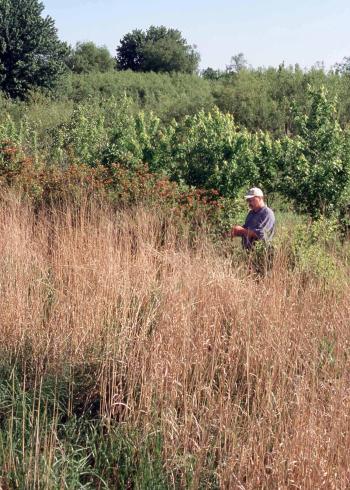Managing Wildlife Habitat on Your Land
How you manage your land affects wildlife, even if your land is idle. Idle land is not necessarily good habitat.
- Periodic disturbance may be needed if you are managing for early-successional species such as cottontail rabbits, bobwhite quail, or species that prefer mixed-successional stages such as white-tailed deer or wild turkey. Although gray or fox squirrels prefer large stands of mature oaks, planning for the next generation of oak trees is necessary for sustaining squirrel habitat. A number of songbirds, small mammals, reptiles and amphibians also thrive in these different habitat types.
- Timing is everything. Exactly when these disturbances occur and the types of plant species present in the seed bed results in different plant responses. Landowners who are willing to experiment can gain understanding about native plant responses to these practices on their property.
- Grow a diversity of plants. The key to providing wildlife habitat is establishing a diversity of plants which provide year-round nutrition and cover for wildlife survival. Wildlife are adapted particularly to native plants that meet many of their habitat needs. Enhancing beneficial native plants is an essential part of any habitat plan. Native forbs and grasses can be established through creating disturbance, such as disking, prescribed fire, and thinning trees.
The University of Arkansas Cooperative Extension Service offers publications, local demonstrations, workshops and field days about improving your land for wildlife habitat. Contact your local county Extension office for information.
Habitat Publications
-
General Wildlife Habitat Practices
12 Wildlife Habitat Tips for Small AcreagesTwelve ideas for improving wildlife habitat on less than 40 acres.
- Wildlife Habitat Management for Arkansas Landowners
Brief overview of 45+ habitat management practices for > 40 acres.
-
Specific Habitat Practices
- Food Plots
- Best Management Practices for Waterbirds on Agricultural Lands
- Evaluating the Management Potential of Upland Hardwood Stands
- Light Disking to Improve Wildlife Habitat in Grasslands and Old Fields
- Managing Pastures and Haylands for Wildlife
- Migratory Stopover Habitat for Shorebirds
- Improve Your Pine Stand by Thinning
- Recommended Chemicals for Weed and Brush Control for Arkansas
- A Riparian Area Assessment Guide for Streamside Landowners
- Riparian Buffers: Functions and Values
- Riparian Buffers: Types and Establishment Methods
- Using Natural Regeneration to Promote Oaks in Upland Hardwood Stands
- Why We Burn: Prescribed Burning As A Management Tool
-
Habitat Assistance
Other Resources
- Arkansas Game and Fish Commission
Private Lands Biologists will provide advice over the telephone for smaller acreages, or help write plans on site for larger acreages.
- Arkansas Forestry Commission
County foresters will help write your timber management plan to balance timber production with improving wildlife habitat. They are also a source for tree seedlings and prescribed fire services on your property.
- USDA Service Centers
Information about available cost-share programs for improving wildlife habitat are available at your local USDA Service Center. USDA Service Centers are designed to be a single location where customers can access the services provided by the Farm Service Agency, Natural Resources Conservation Service, and the Rural Development agencies.
